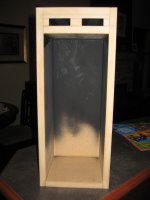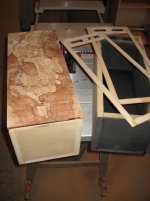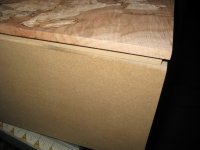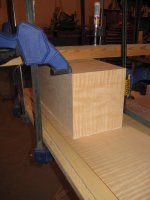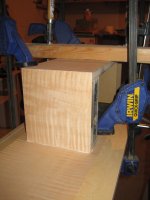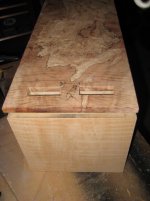the brace atop the port panel is less important than the driver/magnet brace - I've built more than a few pair without the former, and I doubt its absence would be audible
The additional brace is a recent addition. Inspection of early builds with the mechanics stethescope showed that the baffle below the driver was the place most likely to get excited, so a brace was added. The effect on volume is small enuff as to be ignored.
dave
so it seems I did not think through the thickness on the maple face,,, my intent is to glue or sandwich a piece of 10mm mdf to my 9mm maple top..
issue is the plan calls for 15mm face material so my port length will increase by 4 mm. If i understand it correctly that will lower my tuning and decrease power handling..
so i am not sure if this will have any profound effect on my ears?
I could use 7 mm material and then i would only be out by 2 mm but given the heavy spalt of the maple piece i wanted the extra material.
Not sure how to proceed?
-use 7mm material and perhaps add an additional brace and adjust box volume slightly to account for brace but still then be out by 2mm
-keep the 10mm mdf as i originally had planned and adjust box volume slightly. I think i like this plan the best but have no idea what to adjust volume to...
-keep the 10 mm mdf as originally planed and do not adjust box volume?
- make the box depth smaller and increase its height?
as i am attatching the face to the box last, this is not that hard with a few passes on the table saw with the blade set high. As i have a false base and have not mounted the bottom piece yet adjusting internal volume is simple..
other box measurements are precise..
thanks for your insight...
issue is the plan calls for 15mm face material so my port length will increase by 4 mm. If i understand it correctly that will lower my tuning and decrease power handling..
so i am not sure if this will have any profound effect on my ears?
I could use 7 mm material and then i would only be out by 2 mm but given the heavy spalt of the maple piece i wanted the extra material.
Not sure how to proceed?
-use 7mm material and perhaps add an additional brace and adjust box volume slightly to account for brace but still then be out by 2mm
-keep the 10mm mdf as i originally had planned and adjust box volume slightly. I think i like this plan the best but have no idea what to adjust volume to...
-keep the 10 mm mdf as originally planed and do not adjust box volume?
- make the box depth smaller and increase its height?
as i am attatching the face to the box last, this is not that hard with a few passes on the table saw with the blade set high. As i have a false base and have not mounted the bottom piece yet adjusting internal volume is simple..
other box measurements are precise..
thanks for your insight...
so it seems I did not think through the thickness on the maple face,,, my intent is to glue or sandwich a piece of 10mm mdf to my 9mm maple top..
issue is the plan calls for 15mm face material so my port length will increase by 4 mm. If i understand it correctly that will lower my tuning and decrease power handling..
so i am not sure if this will have any profound effect on my ears?
I could use 7 mm material and then i would only be out by 2 mm but given the heavy spalt of the maple piece i wanted the extra material.
Not sure how to proceed?
-use 7mm material and perhaps add an additional brace and adjust box volume slightly to account for brace but still then be out by 2mm
-keep the 10mm mdf as i originally had planned and adjust box volume slightly. I think i like this plan the best but have no idea what to adjust volume to...
-keep the 10 mm mdf as originally planed and do not adjust box volume?
- make the box depth smaller and increase its height?
as i am attatching the face to the box last, this is not that hard with a few passes on the table saw with the blade set high. As i have a false base and have not mounted the bottom piece yet adjusting internal volume is simple..
other box measurements are precise..
thanks for your insight...
IINM, minor variations in internal volume are less critical than the port tuning.
Is it too late to adjust the length of the internal panels that form the slot? If not, you could reduce them and add a filler to the inside of back wall panel to retain the overall length. This filler should probably extend at least 1" above the throat of the slot opening.
well its sorta to late, so you say maintaing the tuning or port length is more important that volume?
this is how the box looks, what if i set the blade high on the table saw and remove 4mm from the front of the box, there by keeping the port length the same as designed? as you see i have not added the bottom of the box or separation from the false area so i could then easily make the box the same volume as designed, just internally not as deep but now slightly taller?
this is how the box looks, what if i set the blade high on the table saw and remove 4mm from the front of the box, there by keeping the port length the same as designed? as you see i have not added the bottom of the box or separation from the false area so i could then easily make the box the same volume as designed, just internally not as deep but now slightly taller?
Attachments
Volume & port tuning are both important.
If you have only gotten as far as in the picture, reach in with a small filr and at least champher the back top (bottom in your case) of the vent shelf.
dave
If you have only gotten as far as in the picture, reach in with a small filr and at least champher the back top (bottom in your case) of the vent shelf.
dave
Volume & port tuning are both important.
If you have only gotten as far as in the picture, reach in with a small filr and at least champher the back top (bottom in your case) of the vent shelf.
dave
would the chamfer be in place of cutting a few mm off the front? or in addition to it? I suspect you suggest a chamfer to decrease port length?
Thanks again guys!
would the chamfer be in place of cutting a few mm off the front? or in addition to it? I suspect you suggest a chamfer to decrease port length?
Thanks again guys!
Unless you're a dental surgeon, the working space inside the cabinet appears to be a bit cramped to swing a rasp without major knuckle bashing.
Since it sounds like you haven't installed the panel sectioning off the "bottom" void cavity and defining the net internal volume, I'd be inclined to trim the front of the box.
Actually, "if" 😉 I was in your shoes, I'd have simply started over again. MDF isn't be the quickest starting kindling around, but a varying portion of Dave's annual Halloween bonfire includes just such miscalculations.
Agreed! MDF is tres cheap!!Unless you're a dental surgeon, the working space inside the cabinet appears to be a bit cramped to swing a rasp without major knuckle bashing.
Since it sounds like you haven't installed the panel sectioning off the "bottom" void cavity and defining the net internal volume, I'd be inclined to trim the front of the box.
Actually, "if" 😉 I was in your shoes, I'd have simply started over again. MDF isn't be the quickest starting kindling around, but a varying portion of Dave's annual Halloween bonfire includes just such miscalculations.
Best, Don
Agreed! MDF is tres cheap!!
Best, Don
in re-reading that last post (too late to edit), the sloppy grammar is somewhat embarrassing, but you got the point?
Chris: Your grammar is impeccable-- (ever read any teenagers text messages?!)
Don
generally, I try to parse for posterity, but
"isn't be"?
would the chamfer be in place of cutting a few mm off the front? or in addition to it? I suspect you suggest a chamfer to decrease port length?
I never advised cutting a few mm off the front (that was your idea). All mods occur at the inside end of the vent.
It is a way of trying to do the same thing. The idea is to "flare" the vent at the internal end, which means you need a slightly longer vent for the same tuning
dave
Actually, "if" 😉 I was in your shoes, I'd have simply started over again. MDF isn't be the quickest starting kindling around, but a varying portion of Dave's annual Halloween bonfire includes just such miscalculations.
gentlemen,, lets not get carried away....after all, I did ingest all that MDF dust and formaldehyde...😛
I never advised cutting a few mm off the front (that was your idea).
dave
Yes, my idea.. Will their be any audible difference with this modification than your original plan? i cant think of any issue, last time i made an asumtion though i got into trouble🙂
so its done,, I shaved 4mm off the face.
If my math is correct, and it normally is not😱 I need to add 6.5mm to the internal height....?
I did a quick mock up of my face detail to give you an idea where I'm going with this...
If my math is correct, and it normally is not😱 I need to add 6.5mm to the internal height....?
I did a quick mock up of my face detail to give you an idea where I'm going with this...
Attachments
progress is slow,, very slow..
Wanted to share a picture of my progress thus far. I am using polyurethane cold press for the veneer, given the thickness of the raw wood, i felt this the best route. I used a router for the slot port openings, it was a tense cut as the spalt is very soft and I was worried it might split
I have been running the alpairs free air to break them in.. 50 or so hours so far.
I hope to finish off the veneer work in the coming week and should find time to cut the driver opening.
Wanted to share a picture of my progress thus far. I am using polyurethane cold press for the veneer, given the thickness of the raw wood, i felt this the best route. I used a router for the slot port openings, it was a tense cut as the spalt is very soft and I was worried it might split

I have been running the alpairs free air to break them in.. 50 or so hours so far.
I hope to finish off the veneer work in the coming week and should find time to cut the driver opening.
Attachments
what are the sound quality differeces between the two?
sealed vs full?
where will i notice the difference?
You mean sealed versus ported?
Sealed:
- Easy to design and build. Can adjust sound with stuffing material choice.
- Below resonance, response decreases 12 dB/octave.
- The sealed cabinet naturally limits the low frequency excursion.
Ported:
- Trickier to design, especially for very compact speakers.
- In small cabinets, it can become literally impossible to fit ports with sufficient cross-sectional area to flow enough air.
- Below the port tuning, the speaker becomes as though in open air and unloaded, and any low bass can bottom the speaker out. The response decreases 24 dB per octave.
I think you'd be much better off with the sealed box, and if the bass is inadequate, add a subwoofer. You simply cannot get low bass out of tiny drivers in tiny enclosures. That is called "Physics" 😛
You mean sealed versus ported?
Sealed:
- Easy to design and build. Can adjust sound with stuffing material choice.
- Below resonance, response decreases 12 dB/octave.
- The sealed cabinet naturally limits the low frequency excursion.
Ported:
- Trickier to design, especially for very compact speakers.
- In small cabinets, it can become literally impossible to fit ports with sufficient cross-sectional area to flow enough air.
- Below the port tuning, the speaker becomes as though in open air and unloaded, and any low bass can bottom the speaker out. The response decreases 24 dB per octave.
I think you'd be much better off with the sealed box, and if the bass is inadequate, add a subwoofer. You simply cannot get low bass out of tiny drivers in tiny enclosures. That is called "Physics" 😛
thanks for your thoughts, in re reading my post there was a typo. my question was what was the difference between seperates or tweeter/woofer versus a single fullrange? and where would i hear the difference? I rely on spellcheck to often i think.
people talk of fullrange magic , but i have no idea what the magic is?
- Status
- Not open for further replies.
- Home
- Loudspeakers
- Full Range
- fullrange vs 2way desktop build
